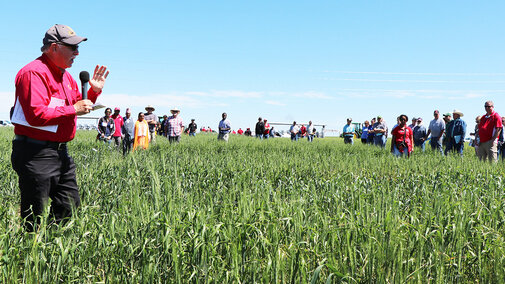Last year I described 2018 as an unusual year, so this must make 2019 another unusual year. However, I really think this year’s precipitation patterns make it hard to provide variety recommendations. I base this on needing to use summaries to get the data to assess consistent performance. Fortunately, the 2019, two-year averages (so you can see what is coming), and three-year averages are posted for the state winter wheat variety trials (https://cropwatch.unl.edu/winter-wheat-variety-test-results). These trials are the best place to look for agronomic performance and common marketing traits such as protein content and test weight.
The difficulty with this year’s data are that we had some pretty major separations in varieties in specific locations. For example, in the Box Butte Irrigated location, NE15420 was 6 bu/ac better than the second-best line. Next year, when the two-year averages are developed, this excellent year performance will give it a real advantage in the two-year means. Some other surprises were that Robidoux topped the dryland trial in Box Butte County at 88.3 bu/ac, but in the irrigated Box Butte County trial, Robidoux was the lowest yielding line at 80.8 bu/ac. Does this mean that Robidoux prefers not having water? I doubt it.
Finally, when you have a year like this with above-normal rainfall, the yield means are very high, which will bias the over-year means to the highest yielding year. For example, a line that yielded 100 bu/ac in 2019, 50 bu/ac in 2018, and 50 bu/ac in 2017 has a three-year average of 66.7 bu/ac. Another variety that yielded 60 bu/ac in 2019, 60 bu/ac in 2018, and 60 bu/ac in 2017 would have a three-year average of 60 bu/ac. If you thought the 2019-2020 growing season was going to be more like 2017 and 2018, which variety would you select?
Having said this, to make your variety selections for the 2019-2020 growing season, I would go to the state winter wheat variety trials website and look at the 2019 data and the 2018 data, especially for those lines that have been tested and reported in the three-years averages for 2018 and 2019. It will give you a better understanding of the varieties’ performances. I will not summarize the data here as you can readily get it from the website.
Another aspect to consider is that while everyone looks at and writes about grain yield, when I talk to growers, especially with these market prices, it is good to look at the other traits that affect the value of your wheat (e.g., test weight and protein content). Test weight is a trait that is generally not too affected by weather swings except for rain at harvest, which lowers test weight. Even in pretty unusual years, the relative difference among lines for test weight will be expressed.
Protein is much more environmentally sensitive than test weight and is more like grain yield (e.g., quite variable). Also, generally the protein content in the variety trials is a little higher than in commercial fields because the alley ways are not planted and there may be more space between plots within a tier, hence each plot has more soil N to draw from in a small plot trial. However, relative genetic differences for protein content will be seen in the data. If you want to avoid discounts at the elevator, look at the test weight and protein content in the state variety report.
It should be noted that the state variety trial report also includes data on winter triticale and barley for those small-grain producers who are interested in those crops.
Support for this research from the Nebraska Wheat Board is gratefully acknowledged.

